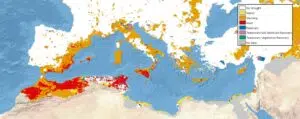Brussels – After weeks of warnings about specific areas in southern Europe – from Sicily to Sardinia to Catalonia – the drought alarm in the Mediterranean becomes an issue of European significance. “Severe and prolonged drought events have affected Europe for more than two years and northern Africa for six years, causing water shortages and hampering vegetation growth,” is the alarm issued today (Feb. 20) by the EU Commission’s Joint Research Center (JRC) in its latest report ‘Drought in the Mediterranean – January 2024’, which formalizes “the critical impact of prolonged drought and record temperatures” in the Mediterranean area. 
The reason for alarm for the rest of 2024 is that “long-lasting, above-average temperatures, warm spells and poor precipitation have led to severe drought conditions” in southern Italy, southern Spain, the island of Malta, Morocco, Algeria, and Tunisia, and very-short-term forecasts are not improving with a warmer spring expected in Southern Italy, Greece, Mediterranean islands and northern Africa, with serious concerns about impacts on agriculture, ecosystems, drinking water availability and energy production. Every tenth of a degree of global warming will increase the risks of prolonged drought, which is why it is made clear in Brussels that immediate adaptation measures are needed for water management and freshwater-dependent sectors, such as agriculture and drinking water production, “in the face of worsening impacts” of climate change.

The drought between Jan. 1 and Jan. 20, 2024 is at record levels, after the hottest year ever recorded by the EU Copernicus satellite program. While the level was “critical” in the southern regions of Italy and Spain and in Malta, the situation was “even more severe and prolonged” in Morocco, Algeria, and Tunisia. The lowest common denominator was the decision to apply “restrictions on water use in response to decreasing water availability.” Reservoirs in Sicily are below the alert level and “water rationing may be necessary to guarantee minimal services.” In Sardinia, water reservoirs were estimated to hold less than 50% of their capacity in December 2023. On February 1, a drought emergency with strict water restrictions was declared in Catalonia, as water reserves fell below 16%. Limitations were also ordered in the southern Portugal region of Algarve, and, in Morocco, the average filling of dams at about 23 percent triggered a ban on using water for street cleaning, irrigation of parks, and some agricultural areas.

Fires in Greece in August 2023 (credits: Spyros Bakalis / Afp)
The most concerning consequences of the drought are on agriculture, with indicators showing alarming conditions in many areas of the Mediterranean region. Lack of rain and record temperatures in January 2024 affected winter crops and fruit trees along the coast of Spain, Italy, Greece, and the Mediterranean islands, while in Morocco and Algeria crop growth has been reduced. Looking ahead, seasonal forecasts see no improvement for the spring: “The current lower-than-usual Alpine snowpack is expected to give a reduced snowmelt contribution to river flows in the region in the upcoming spring and summer seasons.” Even more alarming is the outlook for the summer since “prolonged drought also increases the risk of wildfires due to reduced soil moisture,” as demonstrated last year with the highest fire ever recorded on EU soil (in late August in northeastern Greece).
It is for all these reasons that the EU Commission’s expert group highlights the need for strategies to mitigate the effects of climate change and drought, even given the fact that the United Nations’ Intergovernmental Panel on Climate Change (IPCC) has predicted that heat waves will become more frequent and severe in many regions in the coming decades: “The Mediterranean basin is one of the few regions expected to experience a severe reduction in precipitation.” With a view to continued impact on the region, Brussels makes clear the need for “early warning systems, increasing the water efficiency of existing and new technologies, changing to more drought resistant crops and improving access to water resources.”Drought management will remain “complex,” with a “pragmatic” approach to crisis management and adaptation planning requiring constant work to observe impacts on soils, vegetation, water resources, and communities more broadly.
English version by the Translation Service of Withub




